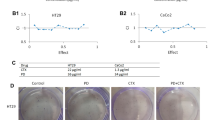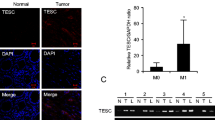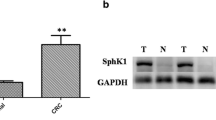Abstract
Sorcin, a soluble resistance-related calcium-binding protein, belongs to the small penta-EF-hand family. Recent study reported that upregulation of sorcin correlated with metastasis and poor prognosis of colorectal cancer (CRC). In the present study, we explored the regulatory role of sorcin in CRC metastasis. To investigate the role of sorcin in CRC metastasis, sorcin overexpressed with empty vector as control in CRC cell line (HCT116). The effect of sorcin overexpression on cell migration and invasion was evaluated via wound healing and transwell assay, respectively. Sorcin-induced changes in EMT process were evaluated by estern blot. Furthermore, the role of PI3K/Akt in the regulatory effect of sorcin on cell migration and invasion, and EMT process was explored by suppressing Akt activity in sorcin-overexpressed HCT116 cells. Sorcin overexpression in HCT116 cells resulted in a significant increase in cell migration and invasion. Sorcin overexpression also markedly promoted the EMT process. More importantly, our results revealed that sorcin stimulated EMT process through activating PI3K/Akt signaling. In summary, this study indicated that the promoting effect of sorcin on CRC metastasis was, at least in part, through PI3K/Akt signaling. The findings in this study highlight the effectiveness and therapeutic potential to utilize sorcin-targeted strategies in the treatment of CRC.





Similar content being viewed by others
References
Byeon, J. S., et al. (2007). Colorectal neoplasm in asymptomatic Asians: A prospective multinational multicenter colonoscopy survey. Gastrointestinal Endoscopy, 65(7), 1015–1022.
Chaffer, C. L., & Weinberg, R. A. (2011). A perspective on cancer cell metastasis. Science, 331(6024), 1559–1564.
Colotti, G., et al. (2014). Sorcin, a calcium binding protein involved in the multidrug resistance mechanisms in cancer cells. Molecules, 19(9), 13976–13989.
Cunningham, D., et al. (2010). Colorectal cancer. Lancet, 375(9719), 1030–1047.
Farrell, E. F., et al. (2003). Sorcin inhibits calcium release and modulates excitation-contraction coupling in the heart. Journal of Biological Chemistry, 278(36), 34660–34666.
Ferlay, J., et al. (2010). Estimates of worldwide burden of cancer in 2008: GLOBOCAN 2008. International Journal of Cancer, 127(12), 2893–2917.
Gao, Y., et al. (2015). Reversing effect and mechanism of soluble resistance-related calcium-binding protein on multidrug resistance in human lung cancer A549/DDP cells. Molecular Medicine Reports, 11(3), 2118–2124.
Gupta, G. P., & Massague, J. (2006). Cancer metastasis: Building a framework. Cell, 127(4), 679–695.
He, Q., et al. (2011). Overexpression of sorcin results in multidrug resistance in gastric cancer cells with up-regulation of P-gp. Oncology Reports, 25(1), 237–243.
Hu, Y., et al. (2013). Inhibition of sorcin reverses multidrug resistance of K562/A02 cells and MCF-7/A02 cells via regulating apoptosis-related proteins. Cancer Chemotherapy and Pharmacology, 72(4), 789–798.
Hu, Y., et al. (2014). Sorcin silencing inhibits epithelial-to-mesenchymal transition and suppresses breast cancer metastasis in vivo. Breast Cancer Research and Treatment, 143(2), 287–299.
Jemal, A., et al. (2009). Cancer statistics, 2009. CA: A Cancer Journal for Clinicians, 59(4), 225–249.
Jemal, A., et al. (2011). Global cancer statistics. CA: A Cancer Journal for Clinicians, 61(2), 69–90.
Kawakami, M., et al. (2007). Knock-down of sorcin induces up-regulation of MDR1 in HeLa cells. Biological and Pharmaceutical Bulletin, 30(6), 1065–1073.
Lalioti, V. S., et al. (2014). Sorcin links calcium signaling to vesicle trafficking, regulates polo-like kinase 1 and is necessary for mitosis. PLoS One, 9(1), e85438.
Li, X., et al. (2013). SOX2 promotes tumor metastasis by stimulating epithelial-to-mesenchymal transition via regulation of WNT/beta-catenin signal network. Cancer Letters, 336(2), 379–389.
Liao, W., et al. (2013). Silencing of DLGAP5 by siRNA significantly inhibits the proliferation and invasion of hepatocellular carcinoma cells. PLoS One, 8(12), e80789.
Liu, X., et al. (2014). Reversing effect of sorcin in the drug resistance of human nasopharyngeal carcinoma. The Anatomical Record (Hoboken), 297(2), 215–221.
Maddalena, F., et al. (2011). Sorcin induces a drug-resistant phenotype in human colorectal cancer by modulating Ca(2+) homeostasis. Cancer Research, 71(24), 7659–7669.
Meyers, M. B., et al. (1995). Association of sorcin with the cardiac ryanodine receptor. Journal of Biological Chemistry, 270(44), 26411–26418.
Meyers, M. B., et al. (1998). Sorcin associates with the pore-forming subunit of voltage-dependent L-type Ca2+ channels. Journal of Biological Chemistry, 273(30), 18930–18935.
Meyers, M. B., et al. (2003). Sorcin regulates excitation-contraction coupling in the heart. Journal of Biological Chemistry, 278(31), 28865–28871.
Parekh, H. K., et al. (2002). Overexpression of sorcin, a calcium-binding protein, induces a low level of paclitaxel resistance in human ovarian and breast cancer cells. Biochemical Pharmacology, 63(6), 1149–1158.
Qi, J., et al. (2006). Overexpression of sorcin in multidrug resistant human leukemia cells and its role in regulating cell apoptosis. Biochemical and Biophysical Research Communications, 349(1), 303–309.
Qu, Y., et al. (2010). Comparative proteomic profiling identified sorcin being associated with gemcitabine resistance in non-small cell lung cancer. Medical Oncology, 27(4), 1303–1308.
Spano, D., et al. (2012). Molecular networks that regulate cancer metastasis. Seminars in Cancer Biology, 22(3), 234–249.
Steeg, P. S. (2006). Tumor metastasis: mechanistic insights and clinical challenges. Nature Medicine, 12(8), 895–904.
Tan, Y., et al. (2003). Expression of sorcin predicts poor outcome in acute myeloid leukemia. Leukemia Research, 27(2), 125–131.
Thiery, J. P., et al. (2009). Epithelial-mesenchymal transitions in development and disease. Cell, 139(5), 871–890.
Yamagishi, N., et al. (2014). Increased expression of sorcin is associated with multidrug resistance in leukemia cells via up-regulation of MDR1 expression through cAMP response element-binding protein. Biochemical and Biophysical Research Communications, 448(4), 430–436.
Zamparelli, C., et al. (2010). Activation of the cardiac Na(+)–Ca(2+) exchanger by sorcin via the interaction of the respective Ca(2+)-binding domains. Journal of Molecular and Cellular Cardiology, 49(1), 132–141.
Zhou, Y., et al. (2006). Sorcin, an important gene associated with multidrug-resistance in human leukemia cells. Leukemia Research, 30(4), 469–476.
Author information
Authors and Affiliations
Corresponding author
Rights and permissions
About this article
Cite this article
Tong, W., Sun, D., Wang, Q. et al. Sorcin Enhances Metastasis and Promotes Epithelial-to-Mesenchymal Transition of Colorectal Cancer. Cell Biochem Biophys 72, 453–459 (2015). https://doi.org/10.1007/s12013-014-0486-3
Published:
Issue Date:
DOI: https://doi.org/10.1007/s12013-014-0486-3




